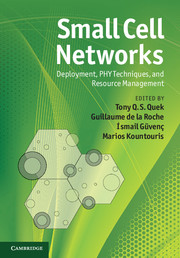Book contents
- Frontmatter
- Contents
- List of contributors
- Foreword by David Chambers
- Acknowledgments
- Acronyms
- 1 Small cell networks overview
- 2 Fundamentals of access control in femtocells
- 3 Coverage analysis using the Poisson point process model
- 4 Interference modeling for cognitive femtocells
- 5 Multiple antenna techniques in small cell networks
- 6 Physical layer techniques for cognitive femtocells
- 7 Femtocell coverage optimization
- 8 Random matrix methods for cooperation in small cell networks
- 9 Mobility in small cell networks
- 10 Cognitive radio resource management in autonomous femtocell networks
- 11 Decentralized reinforcement learning techniques for interference management in heterogeneous networks
- 12 Resource allocation optimization in heterogeneous wireless networks
- 13 New strategies for femto-macro cellular interference control
- 14 Femtocell interference control in standardization
- 15 Spectrum assignment and fairness in femtocell networks
- 16 Self-organization and interference avoidance for LTE femtocells
- Index
- References
14 - Femtocell interference control in standardization
Published online by Cambridge University Press: 05 May 2013
- Frontmatter
- Contents
- List of contributors
- Foreword by David Chambers
- Acknowledgments
- Acronyms
- 1 Small cell networks overview
- 2 Fundamentals of access control in femtocells
- 3 Coverage analysis using the Poisson point process model
- 4 Interference modeling for cognitive femtocells
- 5 Multiple antenna techniques in small cell networks
- 6 Physical layer techniques for cognitive femtocells
- 7 Femtocell coverage optimization
- 8 Random matrix methods for cooperation in small cell networks
- 9 Mobility in small cell networks
- 10 Cognitive radio resource management in autonomous femtocell networks
- 11 Decentralized reinforcement learning techniques for interference management in heterogeneous networks
- 12 Resource allocation optimization in heterogeneous wireless networks
- 13 New strategies for femto-macro cellular interference control
- 14 Femtocell interference control in standardization
- 15 Spectrum assignment and fairness in femtocell networks
- 16 Self-organization and interference avoidance for LTE femtocells
- Index
- References
Summary
User-deployed femtocells, each exclusively serving a set of registered users and sharing the same frequency spectrum as the overlay macrocells, are already defined in 3rd Generation Partnership Project (3GPP) specifications. Such a co-channel and random deployment of femtocells can cause heavy downlink (DL) control and data channel interference especially to mobile user equipment (MUE) in the vicinity of one or more femtocells and not belonging to their closed subscriber groups (CSGs). This chapter is dedicated to addressing this issue, termed as inter-cell interference coordination (ICIC), paying particular attention to the control channel. In systems that employ full frequency reuse, such as long term evolution (LTE), the issue of inter-cell interference (ICI) is a very serious one and can severely compromise cell-edge performance. The situation is further exacerbated in systems with femtocells randomly distributed within the underlying macrocellular network. In such a system, ICI is not only experienced by MUEs at the edge of macrocells, but can also be experienced by those MUEs in the vicinity of one or more femtocells, whose CSGs they are not members of. While scheduling strategies do not come under the purview of LTE standardization, LTE does provide standardized signaling methods so that an appropriate signaling strategy may be employed to avoid excessive ICI for the data channels. However, these signaling methods are developed to be exchanged between macro base stations (BSs) over the X2 interface. It is expected that LTE femtocells will not have access to such an interface. Furthermore, unlike the data channel, the various control channels cannot be conveniently relocated in order to avoid interference.
- Type
- Chapter
- Information
- Small Cell NetworksDeployment, PHY Techniques, and Resource Management, pp. 332 - 356Publisher: Cambridge University PressPrint publication year: 2013

